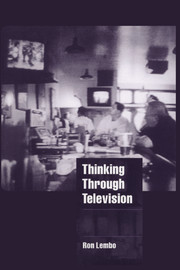Conclusion: The politics of television reconsidered
Published online by Cambridge University Press: 22 September 2009
Summary
I began this book with a scenario of continuous television use, something that I regularly encountered in the lives of television viewers. A guiding theme (or central argument) of the book has been that this way of using television, while quite common, is not well understood by cultural studies analysts, or, for that matter, by more conventional social scientists or social theorists. My initial presentation of continuous use served as a metaphor for the entire range of viewing practices – recognizing formula, simultaneous viewing, channel switching, and image-play – that I have analyzed, practices that largely escape the analytical frameworks that typically guide current accounts of television use. I conclude by returning to my initial claims regarding the limits of cultural studies.
One of my central arguments has been that the conceptual frameworks of cultural studies, (centered as they are on the construction of normative and resistant identifications with mass-media narratives) neither direct attention to nor explain these common and complex image-based viewing practices, and, because of that, fail to understand adequately the sociological significance of television use. My research demonstrates that there is more, much more, to the sociality of the viewing culture than discourses and identities, however multiple and complicated their workings.
The argument can be taken further. My earlier discussion of discrete use suggests that it is in this particular way of using television that the normalizing power of television, so central to cultural studies accounts, is prominently displayed.
- Type
- Chapter
- Information
- Thinking through Television , pp. 232 - 242Publisher: Cambridge University PressPrint publication year: 2000

